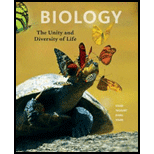
Concept explainers
The number of species on an island depends on the size of the island and its distance from a mainland. This statement would most likely be made by _____.
- a. an explorer
- b. a biogeographer
- c. a geologist
- d. a philosopher
Introduction: Biogeography is the branch of science that deals with the study of various species of animals and plants that had geographically distributed throughout the geological time. The person who studies about the biogeography is known as biogeographer.
Answer to Problem 1SQ
Correct answer: The number of species on an island depends on the size of the island and its distance from the mainland. This statement would most likely be made by a biogeographer.
Hence, the correct answer is option b.
Explanation of Solution
Reason for correct answer:
During the late 1800s, the naturalists started to bring thousands of animals and plants from various parts of the world. They observed the various patterns in different species and also the resemblance in their body parts. Due to this observation, they thought how the natural forces can be able to shape the life in different species. Thus, these studies regarding the various patterns of species in the geographic distribution and its communities were referred as biogeography, and the person who deals with these studies is known as biogeographer. For example, the number of species staying in an island can depend upon various factors including the size of the island in which they live and the distance from their mainland. This can be predicted by the biogeographer.
Option b. is given as “a biogeographer”.
The person who studies about the geographic distribution throughout the geological time is referred as a biogeographer.
Hence, the correct answer is option a.
Reason for incorrect answer:
Option a. is given as “an explorer”.
An explorer is a person who travels or explores new places. These people do not study about the species that is geographically distributed.
Hence, option a. is incorrect.
Option c. is given as “a geologist”.
The person who studies about the earth science and its processes is referred to as a geologist. These people do not study about the species that is geographically distributed.
Hence, option c. is incorrect.
Option d. is given as “a philosopher”.
The person who studies about the philosophy is referred to as a philosopher. These people do not study about the species that is geographically distributed.
Hence, option d. is incorrect.
Hence the options a., c., and d. are incorrect.
Want to see more full solutions like this?
Chapter 16 Solutions
Biology: The Unity and Diversity of Life (MindTap Course List)
Additional Science Textbook Solutions
Fundamentals Of Thermodynamics
Laboratory Manual For Human Anatomy & Physiology
SEELEY'S ANATOMY+PHYSIOLOGY
Biology: Life on Earth with Physiology (11th Edition)
Microbiology Fundamentals: A Clinical Approach
- When beta-lactamase was isolated from Staphylcoccus aureus and treated with a phosphorylating agent, only the active site, serine was phosphorylated. Additionally, the serine was found to constitute 0.35% (by weight) of this beta-lactamase enzyme. Using this, calculate the molecular weight of this enzyme and estimate the number of amino acids present in the polypeptide.arrow_forwardBased on your results from the Mannitol Salt Agar (MSA) media, which of your bacteria were mannitol fermenters and which were not mannitol fermenters?arrow_forwardhelp tutor pleasearrow_forward
- Q8. A researcher wants to study the effectiveness of a pill intended to reduce stomach heartburn in pregnant women. The researcher chooses randomly 400 women to participate in this experiment for 9 months of their pregnancy period. They all need to have the same diet. The researcher designs two groups of 200 participants: One group take the real medication intended to reduce heartburn, while the other group take placebo medication. In this study what are: Independent variable: Dependent variable: Control variable: Experimental group: " Control group: If the participants do not know who is consuming the real pills and who is consuming the sugar pills. This study is It happens that 40% of the participants do not find the treatment helpful and drop out after 6 months. The researcher throws out the data from subjects that drop out. What type of bias is there in this study? If the company who makes the medication funds this research, what type of bias might exist in this research work?arrow_forwardHow do I determine the inhertiance pattern from the pedigree diagram?arrow_forwardits an open book assignemntarrow_forward
- Describe two different gene regulation mechanisms involving methylationarrow_forwardWhat is behavioral adaptarrow_forward22. Which of the following mutant proteins is expected to have a dominant negative effect when over- expressed in normal cells? a. mutant PI3-kinase that lacks the SH2 domain but retains the kinase function b. mutant Grb2 protein that cannot bind to RTK c. mutant RTK that lacks the extracellular domain d. mutant PDK that has the PH domain but lost the kinase function e. all of the abovearrow_forward
 Concepts of BiologyBiologyISBN:9781938168116Author:Samantha Fowler, Rebecca Roush, James WisePublisher:OpenStax College
Concepts of BiologyBiologyISBN:9781938168116Author:Samantha Fowler, Rebecca Roush, James WisePublisher:OpenStax College
 Biology Today and Tomorrow without Physiology (Mi...BiologyISBN:9781305117396Author:Cecie Starr, Christine Evers, Lisa StarrPublisher:Cengage Learning
Biology Today and Tomorrow without Physiology (Mi...BiologyISBN:9781305117396Author:Cecie Starr, Christine Evers, Lisa StarrPublisher:Cengage Learning Biology (MindTap Course List)BiologyISBN:9781337392938Author:Eldra Solomon, Charles Martin, Diana W. Martin, Linda R. BergPublisher:Cengage LearningEssentials Health Info Management Principles/Prac...Health & NutritionISBN:9780357191651Author:BowiePublisher:Cengage
Biology (MindTap Course List)BiologyISBN:9781337392938Author:Eldra Solomon, Charles Martin, Diana W. Martin, Linda R. BergPublisher:Cengage LearningEssentials Health Info Management Principles/Prac...Health & NutritionISBN:9780357191651Author:BowiePublisher:Cengage





